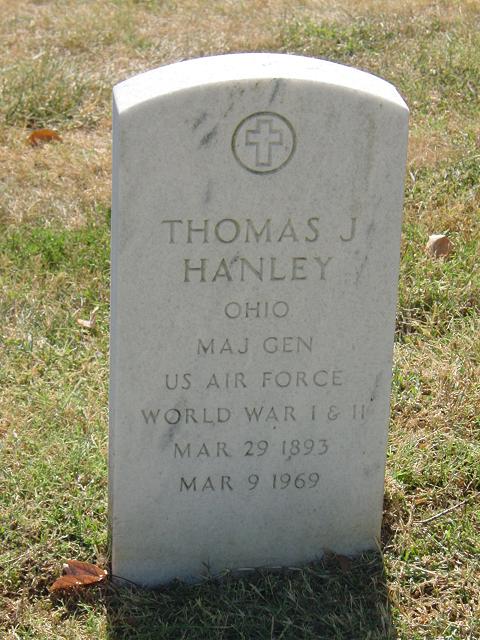Courtesy of the United States Air Force
Suggested By Russell C. Jacobs, June 2007
MAJOR GENERAL THOMAS J. HANLEY JR.
Died March 1, 1969.
Thomas James Hanley Jr., was born at Coshocton, Ohio, in 1893, the third of six children of Thomas J. Hanley Sr., who had come to the United States from Ireland, and the former Miss Mary Margaret O’Connor at Crosson, Pennsylvania.
He graduated from the U.S. Military Academy and was commissioned a Second Lieutenant of Infantry June 12, 1915.
His first assignment was with the 23rd Infantry at Texas City, Texas. In August 1916, he was detailed to the Aviation Section of the Signal Corps and entered the Signal Corps Aviation School at San Diego, California. After graduating from flying school the following April, he was assigned to the First Aero Squadron at Columbus, New Mexico, and a month later transferred to Kelly Field, Texas, where he served successively with the 5th and 19th aero squadrons.
In July 1917, he transferred to Chanute Field, Illinois, as assistant officer in charge of flying at that station. He was designated assistant officer in charge of flying at Rich Field, Texas, in January 1918, and the following month became commanding officer of the 274th Aero Squadron at Taliaferro Field, Texas. In March 1918, he was appointed engineering officer and commanding officer of Taliaferro Field.
Two months later he was appointed commanding officer of Carruthers Field, Texas. From January to February 1919, he took an advanced course in pursuit flying at Rockwell Field, California, and then returned to Carruthers Field, where he served until December 1919.
He then transferred to Langley Field, Virginia, for service as executive officer and in June 1920 was appointed commanding officer of the First Army Observation Group.
On July 1, 1920, he was transferred from the Infantry to the Air Service.
The following month he went to Post Field, Fort Sill, Oklahoma, to organize a detachment of the 135th Squadron and later went to Fort Leavenworth, Kansas, in command of this unit. In November 1920, he returned to Langley Field for duty as director of the administration course and as a student at the Field Officer’s School, later redesignated the Tactical School. In May 1921, he assumed command of the Second Provisional Bombing Group and the 14th Squadron.
He commanded the First Provisional Bombardment Wing briefly in September 1921, and then returned to his duties as instructor at the Tactical School.
In December 1921, he was transferred to the Philippine Islands and assigned to Kindley Field at Fort Mills, where he commanded the second Observation Squadron from March to August 1922 and the Provisional Administration Company until September 1922. He then went to Camp Nichols, Philippine Islands, to assume command of the 28th Bombardment Squadron.
Returning to the United States in March 1924, he assumed command of Crissy Field, California, and the 91st Observation Squadron at that station. He entered the Army Industrial College at Washington in August 1924, and after graduating the following February was assigned to the Office of the Assistant Secretary of War at Washington.
In August 1928, he entered the Command and General Staff School at Fort Leavenworth, Kan., and upon graduation two years later became assistant commandant of the Advanced Flying School at Kelly Field, Texas. In October 1931, he transferred to the Primary Flying School at Randolph Field, Texas, for duty as executive officer and assistant commandant. In June 1932, he became an instructor at the Command and General Staff School and four years later was appointed executive officer of Mitchel Field, New York.
In June 1939, he was named assistant chief of staff for operations of the Puerto Rican Department.
He returned to the United States in June 1941, to assume command of Mitchel Field, New York. Shortly afterward he was named chief of the First Air Force and in November 1941, became First Air Force base commander. The following January he was assigned to AAF headquarters in Washington and appointed assistant chief of air staff for materiel. He later became deputy chief of staff of the AAF and in May 1943, assumed command of the Southeast Air Force Training Center at Maxwell Field, Ala. In April 1944, he went to Patterson Field, Ohio, for a brief tour of duty with the Air Service Command.
The following month he went overseas as commanding general of the China-Burma-India Air Service Command, with station in India. In July 1945, he assumed command of the Army Air Forces in India and Burma, in addition to his duties of the Air Service Command.
Returning to the United States in January 1946, he was assigned to AAF headquarters in Washington and in May of that year went to Air Defense Command headquarters at Mitchel Field, New York. He assumed command of the 11th Air Force at Harrisburg, Pennsylvania, June 14, 1946.
He was appointed chief of the Military Personnel Procurement Service Division in the Office of the Adjutant General at Washington, D.C., in March 1948.
General Hanely became a patient at Walter Reed Army Hospital, Washington, D.C., in September 1951.
General Hanley has been awarded the Distinguished Service Medal, Legion of Merit with oak leaf cluster, Air Medal and American Defense Medal, and is an honorary member of the Yugoslav and Chinese air forces. He is rated a command pilot, combat observer and tactical observer.
HANLEY, THOMAS J
- MG USAF
- DATE OF BIRTH: 03/29/1893
- DATE OF DEATH: 03/09/1969
- BURIED AT: SECTION 13 SITE 5-W
ARLINGTON NATIONAL CEMETERY
Michael Robert Patterson was born in Arlington and is the son of a former officer of the US Army. So it was no wonder that sooner or later his interests drew him to American history and especially to American military history. Many of his articles can be found on renowned portals like the New York Times, Washingtonpost or Wikipedia.
Reviewed by: Michael Howard

